英语八大时态总结一览表
英语常用八大时态

英语常用八大时态一、一般现在时:1. 时间状语:always, usually, often, sometimes其他:every day2. 基本结构: ①主语+be(am,is,are)+表语②主语+V.+宾语3. 否定形式:①主+am/is/are+ not+表语;②主+ don't / doesn't+ V 原形+宾语4. 一般疑问句:①把be动词放于句首②把do / does提到句首5. 例句:1) He is my good friend.He is not my good friend.Is he your good friend?Yes, he is. / No, he isn’t.Who is your good friend?2) She likes playing the piano.She doesn’t like playing the piano.Does she like playing the piano?Yes, she does. / No, s he doesn’t.What does she like doing?★第三人称单数,动词加s+s plays+es teaches去y+ ies studies二、现在进行时:1. 时间状语:now, at this time, these days其他:look / listen / 祈使句后面2. 基本结构:主+be(am/is/are)+doing3. 否定形式:主+be(am/is/are)+ not+ doing4. 一般疑问句:把be动词放于句首。
5. 例句:1)He is doing his homework.He is not doing his homework.Is he doing his homework?Yes, he is. / No, he isn’t.What is he doing?★动词加ing+ing playing去e+ing dancing双写+ing shopping三、一般过去时:1. 时间状语:ago, yesterday, last week, just now,this morning, the day before yesterday,in 1990, in the past2. 基本结构:①主+ be(was were)+表语②主语+V过去式+宾语3. 否定形式:①主+be(was/were)not+表语;②主+did not +V(原形)+表语4. 一般疑问句:① was were放于句首;② did用于句首,动词变回原形。
英语八大时态归纳总结
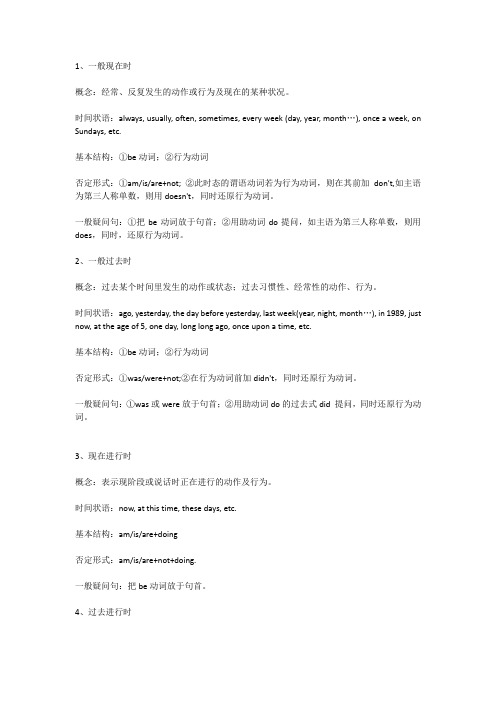
1、一般现在时概念:经常、反复发生的动作或行为及现在的某种状况。
时间状语:always, usually, often, sometimes, every week (day, year, month…), once a week, on Sundays, etc.基本结构:①be动词;②行为动词否定形式:①am/is/are+not; ②此时态的谓语动词若为行为动词,则在其前加don't,如主语为第三人称单数,则用doesn't,同时还原行为动词。
一般疑问句:①把be动词放于句首;②用助动词do提问,如主语为第三人称单数,则用does,同时,还原行为动词。
2、一般过去时概念:过去某个时间里发生的动作或状态;过去习惯性、经常性的动作、行为。
时间状语:ago, yesterday, the day before yesterday, last week(year, night, month…), in 1989, just now, at the age of 5, one day, long long ago, once upon a time, etc.基本结构:①be动词;②行为动词否定形式:①was/were+not;②在行为动词前加didn't,同时还原行为动词。
一般疑问句:①was或were放于句首;②用助动词do的过去式did 提问,同时还原行为动词。
3、现在进行时概念:表示现阶段或说话时正在进行的动作及行为。
时间状语:now, at this time, these days, etc.基本结构:am/is/are+doing否定形式:am/is/are+not+doing.一般疑问句:把be动词放于句首。
4、过去进行时概念:表示过去某段时间或某一时刻正在发生或进行的行为或动作。
时间状语:at this time yesterday, at that time或以when引导的谓语动词是一般过去时的时间状语等。
英语八大时态总结一览表

Hegoesto school every day.
Ioftenhavelu
主语+动词过去式
(did或者be—was/ were)
st系列,last night/week/month/year
2....ago系列, a second ago/ten years ago
3.yesterday系列, yesterday morning/afternoon/evening
4.just now意为“刚才”
5.in+过去年份如:in 2008
6.童话系列,one day/long long ago/once upon a time
分词
1.直到现在;by now,till now,until now,so far
2.次数;never/once/ever3已经;already/yet
4for+一段时间;since+时间点
5近来的;recently,lately,
Hehas sleptfor two days.
Ihave been teachingfor 8 years.
3.祈使句;look,listen
Tomis writingnow.
Theyare lyingon the bed.
.过去进行时
表示在在过去某时间点、段正在发生的动作或与过去的某个动作同时发生的另一个动作
主语+was / were +动词-ing
1.那时那刻;at that time/moment,just then,at+点+过去,at this time +过去如:at this time yesterday
英语八大时态归纳总结
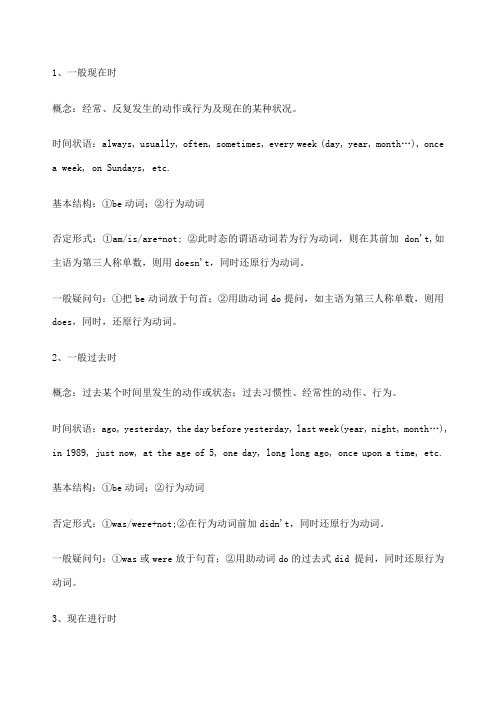
1、一般现在时概念:经常、反复发生的动作或行为及现在的某种状况。
时间状语:always, usually, often, sometimes, every week (day, year, month…), once a week, on Sundays, etc.基本结构:①be动词;②行为动词否定形式:①am/is/are+not; ②此时态的谓语动词若为行为动词,则在其前加don't,如主语为第三人称单数,则用doesn't,同时还原行为动词。
一般疑问句:①把be动词放于句首;②用助动词do提问,如主语为第三人称单数,则用does,同时,还原行为动词。
2、一般过去时概念:过去某个时间里发生的动作或状态;过去习惯性、经常性的动作、行为。
时间状语:ago, yesterday, the day before yesterday, last week(year, night, month…), in 1989, just now, at the age of 5, one day, long long ago, once upon a time, etc.基本结构:①be动词;②行为动词否定形式:①was/were+not;②在行为动词前加didn't,同时还原行为动词。
一般疑问句:①was或were放于句首;②用助动词do的过去式did 提问,同时还原行为动词。
3、现在进行时概念:表示现阶段或说话时正在进行的动作及行为。
时间状语:now, at this time, these days, etc.基本结构:am/is/are+doing否定形式:am/is/are+not+doing.一般疑问句:把be动词放于句首。
4、过去进行时概念:表示过去某段时间或某一时刻正在发生或进行的行为或动作。
时间状语:at this time yesterday, at that time或以when引导的谓语动词是一般过去时的时间状语等。
八个时态总汇表格,完整版
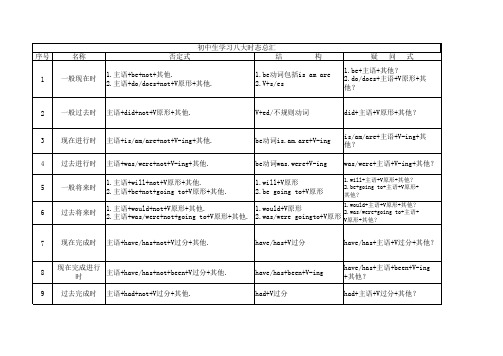
7
现在完成时
主语+have/has+not+V过分+其他.
have/has+V过分
have/has+主语+V过分+其他? have/has+主语+been+V-ing +其他? had+主语+V过分+其他?
8 9
现在完成进行时 主语+have/has+not+been+V过分+其他. 过去完成时 主语+had+not+V过分+其他.
序号 1
名称 一般现在时
否定式
初中生学习八大时态总汇 结
构
疑
问
式
1.主语+be+not+其他. 2.主语+do/does+not+V原形+其他.
1.be动词包括is am are 2.V+s/es
1.beቤተ መጻሕፍቲ ባይዱ主语+其他? 2.do/does+主语+V原形+其 他?
2
一般过去时
主语+did+not+V原形+其他.
Yes,主语+have/has.
No,主语+have/has+not.
Yes,主语+have/has. Yes,主语+had.
No,主语+have/has+not. No,主语+had+not.
Yes,主语+did.
No,主语+did+not
Yes,主语+be.
(完整版)英语常用的八种时态

英语时态初中阶段应掌握的时态共有八种,即一般现在时,一般将来时,一般过去时,现在进行时,过去进行时,过去将来时,现在完成时,过去完成时。
现从结构,作用,时间状语三方面加以介绍。
●动词形式分五种:1.动词原形→ 2.第三人称单数→ 3.过去式→ 4.过去分词→ 5.现在分词一、一般现在时其结构为:be动词肯定句主语+am,is,are+其它。
否定句主语+am,is,are + not+其它。
一般疑问句 Am,Is,Are+主语+其它?特殊疑问句特殊疑问词+am,is,are+主语+其它?实意动词1)主语为第一,二人称及第三人称复数时肯定句主语+动词原形+其它。
否定句主语+don't+动词原形+其它。
一般疑问句 Do +主语+动词原形+其它?特殊疑问句特殊疑问词+do+主语+动词原形+其它?2)主语为第三人称单数时肯定句主语+动词第三人称单数 +其它。
否定句主语+doesn't+动词原形+其它。
一般疑问句 Does+主语+动词原形+其它?特殊疑问句特殊疑问词+does+主语+动词原形+其它?其作用为:表示习惯性,经常性的动作;表示现在的状态与特征;表示普遍真理其常用时间状语为often,always,usually,sometimes,everyday(week,year...), in the morning(afternoon,evening)等。
Ex . 1. _______ she _______ (go)to the library every Sunday?此题为习惯性动作,答案为Does,go.2.They often _______(swim)in summer.此题为经常性动作,答案为swim.3.______(be)everyone here?此题表示现在的状态,答案为Is.4.The earth______(travel) round the sun.此题表示普遍真理,答案为travels.二、一般过去时其结构为:be动词肯定句主语+was,were+其它。
英语八大时态应用总结一览表

英语八大时态应用总结一览表一般现在时 (Simple Present Tense)- 描述常规或惯性动作:- I eat breakfast every day.(我每天都吃早餐。
)- 表达真理或普遍事实:- The sun rises in the east.(太阳从东方升起。
)现在进行时 (Present Continuous Tense)- 表示当前正在进行的动作:- I am studying for my exam.(我正在为考试而研究。
)- 表示暂时的行为或状况:- She is staying at a hotel while her house is being renovated.(她的房子在装修期间暂住在一家酒店。
)一般过去时 (Simple Past Tense)- 描述过去发生的具体事件:- I visited my grandparents last weekend.(上周末我去拜访了我的祖父母。
)- 表达过去的惯或状态:- She used to live in New York.(她过去住在纽约。
)过去进行时 (Past Continuous Tense)- 表示过去某一时刻正在进行的动作:- They were having dinner when the phone rang.(电话响起时,他们正在吃晚饭。
)- 表示过去某一时刻的背景情况:- I was reading a book while it was raining outside.(外面正在下雨时,我正在读书。
)一般将来时 (Simple Future Tense)- 表示将来发生的动作或事件:- We will have a meeting tomorrow.(我们明天将开会。
)- 表示预测或假设:- I think it will rain later.(我认为天会下雨。
)将来进行时 (Future Continuous Tense)- 表示将来某一时刻正在进行的动作:- They will be traveling to Europe this time next year.(明年这个时候,他们将在欧洲旅行。
初中英语八种时态一览表 (精华版)

初中英语八种时态一览表 (精华版)作发生在现在之前,常用于叙述过去的经历和事件。
通常与具体时间状语连用,如yesterday。
last week。
two years ago 等。
例如:Yesterday。
I went to the park with my friends.现在进行时表示现在正在进行的动作或状态。
通常用于现在时态的句子中,使用现在分词形式。
例如:I am studying English now.过去进行时表示过去某一时刻正在进行的动作或状态。
通常与具体时间状语连用,如yesterday at this time。
while I was cooking dinner等。
使用过去式be动词(were/was)和动词的现在分词形式。
例如:I was watching TV when he called me.一般将来时表示将要发生的动作或状态。
通常用于表示未来的计划或打算。
使用will/shall加动词原形。
例如:I will go to the XXX.过去将来时表示过去某个时间点将要发生的动作或状态。
通常与具体时间状语连用,使用过去式be动词(were/was)和动词的原形。
例如:Yesterday at this time。
I was going to theparty with my friends.现在完成时表示过去发生的动作对现在的影响或过去延续到现在的动作或状态。
使用have/has加动词的过去分词形式。
例如:I have finished my homework。
so I can relax now.过去完成时表示过去某个时间点之前已经完成的动作或状态。
通常与具体时间状语连用,使用had加动词的过去分词形式。
例如:By the time I arrived。
he had already left.需要使用连词that来引导。
When writing an article。
初中英语八大时态总结归纳

初中英语八大时态
一般现在时:am/is/are + 动词原形
一般过去时:was/were + 动词的过去式
现在进行时:am/is/are + 动词的现在分词
过去进行时:was/were + 动词的现在分词
一般将来时:will + 动词原形
过去将来时:助动词would + 动词原形或was/were going to + 动词原形
现在完成时:助动词have/has + 动词的过去分词
过去完成时:助动词had + 动词的过去分词
一般现在时:every day,week,mouth,year,always,usually,often,sometimes,seldom 一般过去时:yesterday,the day,before,yesterday,just,now,ago,last week
现在进行时:now,these days,this week,all the time
过去进行时:at the day,then,this time yesterday,the hole morning
一般将来时:tomorrow,the day after tomorrow,next time,from now on,later (on),soon 过去将来时:the next day,the following week,soon,one day,in a week
现在完成时:already,yet,never,so far,since,before。
八大时态总结
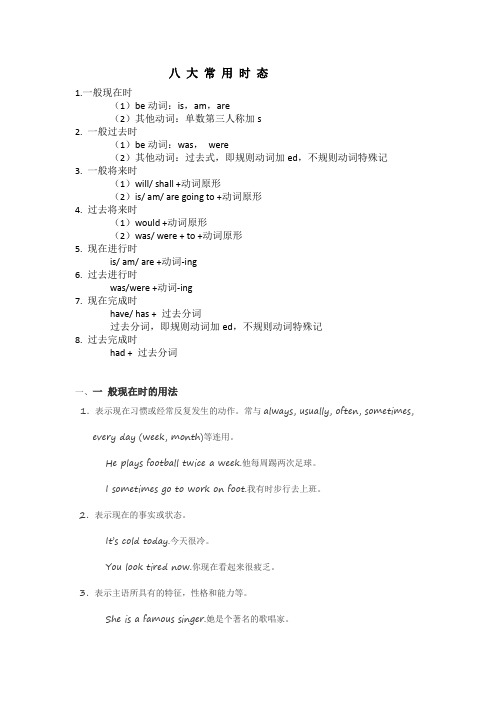
八大常用时态1.一般现在时(1)be动词:is,am,are(2)其他动词:单数第三人称加s2. 一般过去时(1)be动词:was,were(2)其他动词:过去式,即规则动词加ed,不规则动词特殊记3. 一般将来时(1)will/ shall +动词原形(2)is/ am/ are going to +动词原形4. 过去将来时(1)would +动词原形(2)was/ were + to +动词原形5. 现在进行时is/ am/ are +动词-ing6. 过去进行时was/were +动词-ing7. 现在完成时have/ has + 过去分词过去分词,即规则动词加ed,不规则动词特殊记8. 过去完成时had + 过去分词一、一般现在时的用法1.表示现在习惯或经常反复发生的动作。
常与always, usually, often, sometimes, every day (week, month)等连用。
He plays football twice a week.他每周踢两次足球。
I sometimes go to work on foot.我有时步行去上班。
2.表示现在的事实或状态。
It’s cold today.今天很冷。
You look tired now.你现在看起来很疲乏。
3.表示主语所具有的特征,性格和能力等。
She is a famous singer.她是个著名的歌唱家。
Tom likes swimming. 汤姆喜欢游泳。
4.表示客观事实或普遍真理。
I t’s far from the earth to the sun.地球与太阳间的距离很远。
Five and three makes eight.五加三得八。
5.表示已预先安排或计划好将来确定会发生的动作。
如列车时刻等。
但主要用于go, come, leave, start, return, arrive等瞬间动词。
The train from London arrives at 7:00.从伦敦来的火车7:00到站。
八大时态的结构表

八大时态的结构表英语的八大时态有:一般现在时(主语+do/does)、一般过去时(主语+did)、一般将来时、现在进行时、过去进行时、过去将来时、现在完成时和过去完成时。
一、一般现在时:主语+do/does(现在分词)基本结构:①动词原形②主语第三人称单数:动词原形+s/es三种常考基本用法:1、经常性和习惯性动作2、客观事实和普遍真理3、在时间状语从句及条件状语从句中,一般现在表将来常见时间状语:always, usually, often, sometimes, every day, on Sundays, at weekends, once a week, twice a month, etc.二、一般过去时:主语+did基本结构:动词的过去式基本用法:1、过去某个时间里发生的动作或状态2、过去习惯性、经常性的动作常见时间状语:ago, yesterday, the day before yesterday, last week (year, night, month), in 1986, just now, at the age of 10, at that time, once upona time, etc.三、一般将来时:will do/基本结构:①am/is/are/going to + do;②will/shall + do.基本用法:1、(人)计划打算做某事2、(事)即将发生will/shall do1、将来的动作和状态(相对较长远)2、礼貌询问、客气邀请3、意愿常见时间状语:tomorrow, next day (week, month, year), soon, the day after tomorrow, in+时间段(格外注意),etc.四、现在进行时:主语+am/is/are doing基本结构:am/is/are+现在分词基本用法:1、此时此刻正在进行的动作2、现阶段正在进行的动作常见时间状语:now, at this time, these days, etc.五、过去进行时:was/were doing基本结构:was/were+现在分词基本用法:1、过去某时刻正在进行的动作2、过去某时段正在进行的动作常见时间状语:at this time yesterday, at that time或以when引导的谓语动词是一般过去时的时间状语等.六、过去将来时:was/were to /would do基本结构:①was/were/going to + do;②would/should + do.基本用法:从过去时间点看将来,常用于宾语从句中.常见时间状语:the next day (morning, year), the following month (week), etc.七、现在完成时:have/has done基本结构:have/has + 过去分词基本用法:1、过去发生的动作对现在造成的影响或结果2、过去已经开始,持续到现在的动作或状态常见时间状语:recently, lately, so far, up to now, since+时间点,for+时间段, in the past few years, etc.八、过去完成时:had done基本结构:had + 过去分词基本用法:以过去某个时间为标准,在此以前发生的动作或行为,即过去的过去.常见时间状语:before, after, by the end of last year(month),etc.。
英语八大时态
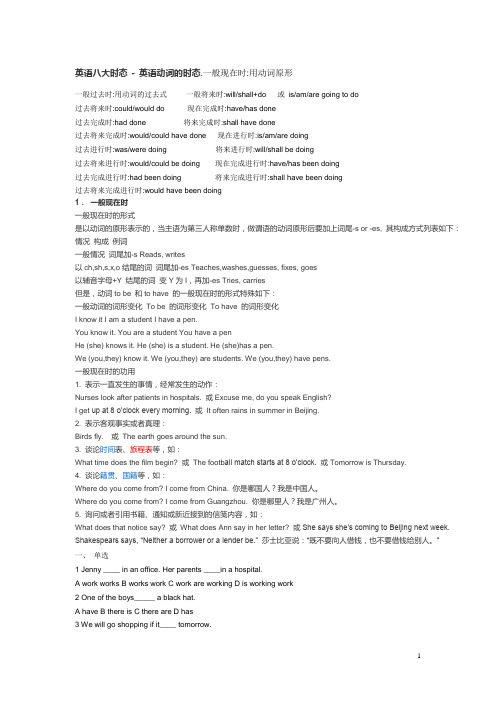
英语八大时态- 英语动词的时态.一般现在时:用动词原形一般过去时:用动词的过去式一般将来时:will/shall+do 或is/am/are going to do过去将来时:could/would do 现在完成时:have/has done过去完成时:had done 将来完成时:shall have done过去将来完成时:would/could have done 现在进行时:is/am/are doing过去进行时:was/were doing 将来进行时:will/shall be doing过去将来进行时:would/could be doing 现在完成进行时:have/has been doing过去完成进行时:had been doing 将来完成进行时:shall have been doing过去将来完成进行时:would have been doing1.一般现在时一般现在时的形式是以动词的原形表示的,当主语为第三人称单数时,做谓语的动词原形后要加上词尾-s or -es, 其构成方式列表如下:情况构成例词一般情况词尾加-s Reads, writes以ch,sh,s,x,o结尾的词词尾加-es Teaches,washes,guesses, fixes, goes以辅音字母+Y 结尾的词变Y为I,再加-es Tries, carries但是,动词to be 和to have 的一般现在时的形式特殊如下:一般动词的词形变化To be 的词形变化To have 的词形变化I know it I am a student I have a pen.You know it. You are a student You have a penHe (she) knows it. He (she) is a student. He (she)has a pen.We (you,they) know it. We (you,they) are students. We (you,they) have pens.一般现在时的功用1. 表示一直发生的事情,经常发生的动作:Nurses look after patients in hospitals. 或Excuse me, do you speak English?I get up at 8 o’clock every morning. 或It often rains in summer in Beijing.2. 表示客观事实或者真理:Birds fly. 或The earth goes around the sun.3. 谈论时间表、旅程表等,如:What time does the film begin? 或The footb all match starts at 8 o’clock. 或Tomorrow is Thursday.4. 谈论籍贯、国籍等,如:Where do you come from? I come from China. 你是哪国人?我是中国人。
英语初中八大时态
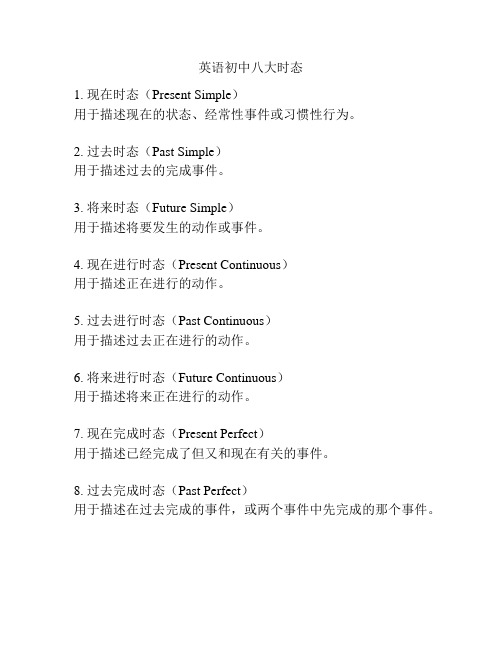
英语初中八大时态
1. 现在时态(Present Simple)
用于描述现在的状态、经常性事件或习惯性行为。
2. 过去时态(Past Simple)
用于描述过去的完成事件。
3. 将来时态(Future Simple)
用于描述将要发生的动作或事件。
4. 现在进行时态(Present Continuous)
用于描述正在进行的动作。
5. 过去进行时态(Past Continuous)
用于描述过去正在进行的动作。
6. 将来进行时态(Future Continuous)
用于描述将来正在进行的动作。
7. 现在完成时态(Present Perfect)
用于描述已经完成了但又和现在有关的事件。
8. 过去完成时态(Past Perfect)
用于描述在过去完成的事件,或两个事件中先完成的那个事件。
(完整版)初中英语八种基本时态总结

初中英语基本时态总结Ⅰ、一般现在时1、概念:1)表示经常性或习惯性的动作,常与表示频度的时间状语连用。
时间状语:always, usually, often, sometimes, seldom, never, every day, twice a week, on Sunday, etc.(提问用How often)例:I leave home for school at 7 every morning.Tom gets up at 6:00 every morning.2)客观真理,客观存在,科学事实。
例:The earth moves around the sun. 地球绕太阳转动。
Shanghai lies in the east of China. 上海位于中国东部。
3)格言或警句。
例:Pride goes before a fall. 骄者必败。
注意:宾语从句中,即使主句是过去时,从句谓语是客观真理也要用一般现在时。
例:Columbus proved that the earth is round. 哥伦布证实了地球是圆的。
2、结构:表状态S+ am/is/are+ P (句中有实义动词不用be)表动作S+V原+O (若主语是单三人称,谓动加s/es。
)3、句式变化:变疑问,有be把be提到主语前;无be在主语前加do/does,谓动变为原形。
变否定,有be在be后加“not”;无be在主语后加don’t/doesn’t,谓动变为原形。
例:①They are in the classroom. →Are they in the classroom? Yes, they are./No, they aren’t. →They aren’t in the classroom②He often waters the flowers . → Does he often water the flowers?Yes, he does. / No, he doesn’t. →He doesn’t often water the flowersⅡ、一般过去时1、概念:1)表示在确定的过去时间里所发生的动作或存在的状态。
初中英语八大时态总表

主动
结构
was/were + V-ing
have/has + V.pp
should + V.原would + V.原
was/ were going to + V.原
had + V.pp
被动结构
was/were + being +V.pp
have/has been + V.pp
would be + V.pp
Am/is/are + being + V.pp
项目分类
过去进行时
现在完成时
过去将来时
过去完成时
定
义
表示过去某一时刻或
某一段时间正在进行的动作。
1.表示过去发生的动作对现在
造成的影响或结果。
2.表示过去发生的动作一直持续
到现在。
表示从过去某一时间看将要发生的动作或存在的状态。经完成的动作或状态。
初中英语时态总结
一般现在时
一般过去时
一般将来时
现在进行时
定
义
1.表示经常性、习惯性动作。
2.表示客观事实或永恒真理。
3.表示特征、爱好、状态和能力等。
表示在过去某一点或
某一段时间发生的动
作或存在的状态。
1.表示将来某个时间要发生的
动作或存在的状态.
2.表示将来经常或反复发生
的动作.
1.表示现在(说话瞬间)正在进行或发生的动作.
2.表示当前一段时间内的活动或现阶段正在进行的动作.
主动结构
V.原主语(单三)+ V.s/es
V.ed
1.will + V.原
英语常用八大时态
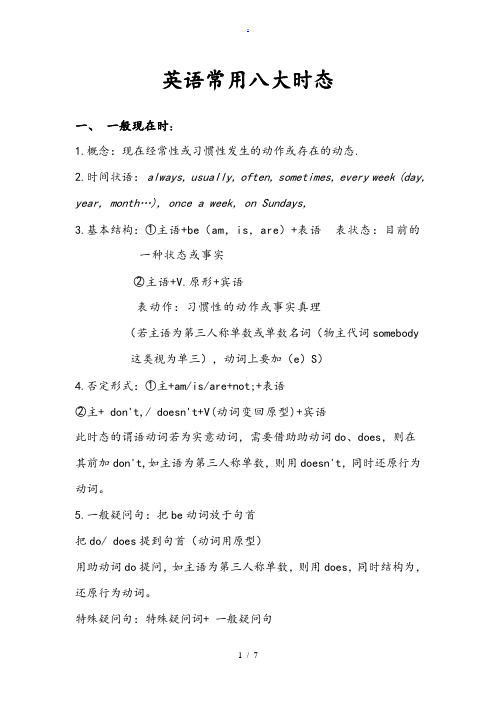
英语常用八大时态一、一般现在时:1.概念:现在经常性或习惯性发生的动作或存在的动态.2.时间状语: always, usually, often, sometimes, every week (day, year, month…), once a week, on Sundays,3.基本结构:○1主语+be(am,is,are)+表语表状态:目前的一种状态或事实○2主语+V.原形+宾语表动作:习惯性的动作或事实真理(若主语为第三人称单数或单数名词(物主代词somebody这类视为单三),动词上要加(e)S)4.否定形式:○1主+am/is/are+not;+表语○2主+ don't,/ doesn't+V(动词变回原型)+宾语此时态的谓语动词若为实意动词,需要借助助动词do、does,则在其前加don't,如主语为第三人称单数,则用doesn't,同时还原行为动词。
5.一般疑问句:把be动词放于句首把do/ does提到句首(动词用原型)用助动词do提问,如主语为第三人称单数,则用does,同时结构为,还原行为动词。
特殊疑问句:特殊疑问词+ 一般疑问句6.例句:. It seldom snows here.He is always ready to help others.Action speaks louder than words.二、一般过去时:1.概念:过去某个时间里发生的动作或状态;过去习惯性、经常性的动作、行为。
2.时间状语:ago, yesterday, the day before yesterday, last week(year, night, month…), in 1989, just now, at the age of 5, one day, long long ago, once upon a time, etc.3.基本结构:○1主+ be(was were)+其他(表示过去的状态或事实)。
英语语法八大时态总结 建议收藏
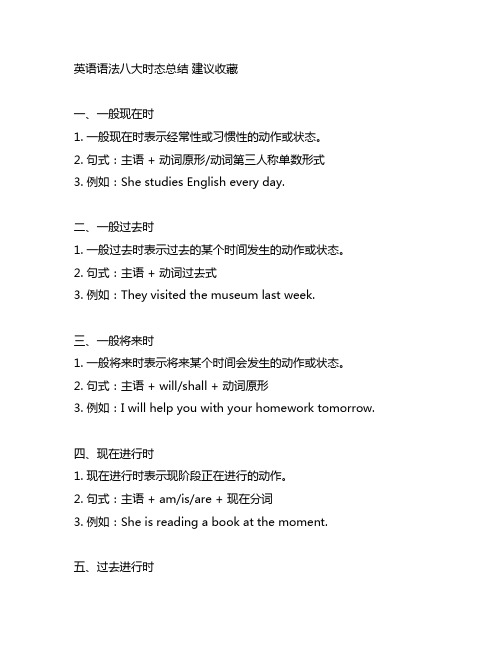
英语语法八大时态总结建议收藏一、一般现在时1. 一般现在时表示经常性或习惯性的动作或状态。
2. 句式:主语 + 动词原形/动词第三人称单数形式3. 例如:She studies English every day.二、一般过去时1. 一般过去时表示过去的某个时间发生的动作或状态。
2. 句式:主语 + 动词过去式3. 例如:They visited the museum last week.三、一般将来时1. 一般将来时表示将来某个时间会发生的动作或状态。
2. 句式:主语 + will/shall + 动词原形3. 例如:I will help you with your homework tomorrow.四、现在进行时1. 现在进行时表示现阶段正在进行的动作。
2. 句式:主语 + am/is/are + 现在分词3. 例如:She is reading a book at the moment.五、过去进行时1. 过去进行时表示过去某一时间正在进行的动作。
2. 句式:主语 + was/were + 现在分词3. 例如:They were playing football when it started to rain.六、现在完成时1. 现在完成时表示过去某个时间开始的动作一直持续到现在或对现在产生影响的动作。
2. 句式:主语 + have/has + 过去分词3. 例如:I have finished my homework.七、过去完成时1. 过去完成时表示在过去某个时间之前已经发生或完成的动作。
2. 句式:主语 + had + 过去分词3. 例如:She had already left when I arrived.八、将来完成时1. 将来完成时表示将来某个时间之前已经发生或完成的动作。
2. 句式:主语 + will/shall + have + 过去分词3. 例如:I will have completed the project by next month.总结回顾英语语法中的八大时态对于学习英语的人来说是十分重要的。
初中英语语法八大时态总结表格
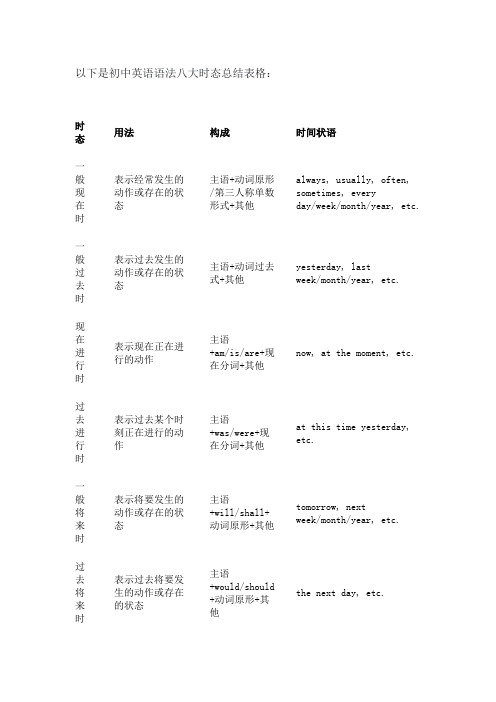
以下是初中英语语法八大时态总结表格:时态用法构成时间状语一般现在时表示经常发生的动作或存在的状态主语+动词原形/第三人称单数形式+其他always, usually, often,sometimes, everyday/week/month/year, etc.一般过去时表示过去发生的动作或存在的状态主语+动词过去式+其他yesterday, lastweek/month/year, etc.现在进行时表示现在正在进行的动作主语+am/is/are+现在分词+其他now, at the moment, etc.过去进行时表示过去某个时刻正在进行的动作主语+was/were+现在分词+其他at this time yesterday,etc.一般将来时表示将要发生的动作或存在的状态主语+will/shall+动词原形+其他tomorrow, nextweek/month/year, etc.过去将来时表示过去将要发生的动作或存在的状态主语+would/should+动词原形+其他the next day, etc.时态用法构成时间状语现在完成时表示过去发生的动作对现在造成的影响或结果主语+have/has+过去分词+其他already, yet, ever, never,for/since, etc.过去完成时表示过去某个时间之前已经完成的动作主语+had+过去分词+其他by the time, before, etc.需要注意的是,这些时态的构成和用法可能会有一些例外情况,具体取决于语境和句子结构。
此外,不同的教材和地区可能会有一些差异,因此在学习过程中,建议你参考多种资料,以便更好地理解和掌握这些时态。
英语八大时态总结表
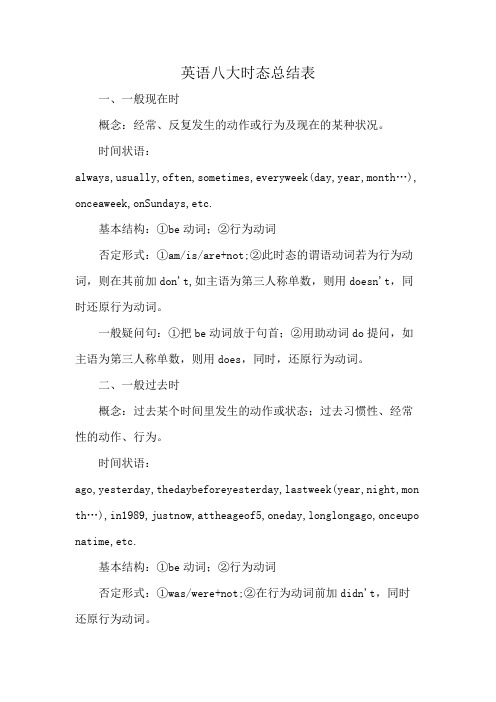
英语八大时态总结表一、一般现在时概念:经常、反复发生的动作或行为及现在的某种状况。
时间状语:always,usually,often,sometimes,everyweek(day,year,month…), onceaweek,onSundays,etc.基本结构:①be动词;②行为动词否定形式:①am/is/are+not;②此时态的谓语动词若为行为动词,则在其前加don't,如主语为第三人称单数,则用doesn't,同时还原行为动词。
一般疑问句:①把be动词放于句首;②用助动词do提问,如主语为第三人称单数,则用does,同时,还原行为动词。
二、一般过去时概念:过去某个时间里发生的动作或状态;过去习惯性、经常性的动作、行为。
时间状语:ago,yesterday,thedaybeforeyesterday,lastweek(year,night,mon th…),in1989,justnow,attheageof5,oneday,longlongago,onceupo natime,etc.基本结构:①be动词;②行为动词否定形式:①was/were+not;②在行为动词前加didn't,同时还原行为动词。
一般疑问句:①was或were放于句首;②用助动词do的过去式did提问,同时还原行为动词。
三、现在进行时概念:表示现阶段或说话时正在进行的动作及行为。
时间状语:now,atthistime,thesedays,etc.基本结构:am/is/are+doing否定形式:am/is/are+not+doing.一般疑问句:把be动词放于句首。
四、过去进行时概念:表示过去某段时间或某一时刻正在发生或进行的行为或动作。
时间状语:atthistimeyesterday,atthattime或以when引导的谓语动词是一般过去时的时间状语等。
基本结构:was/were+doing否定形式:was/were+not+doing.一般疑问句:把was或were放于句首。
- 1、下载文档前请自行甄别文档内容的完整性,平台不提供额外的编辑、内容补充、找答案等附加服务。
- 2、"仅部分预览"的文档,不可在线预览部分如存在完整性等问题,可反馈申请退款(可完整预览的文档不适用该条件!)。
- 3、如文档侵犯您的权益,请联系客服反馈,我们会尽快为您处理(人工客服工作时间:9:00-18:30)。
3.连词;当...时.when,while,(just) as
Hewas readingat that timelast Friday
现在完成时
表示过去的动作到现as +动词过去
Hewrotea letter yesterday.
Iwasborn in1979.
一般将来时
表示将要发生的动作或
存在的状态
主语+be going to/will/shall+
动词原形
1.tomorrow系列, the day after tomorrow
2.next系列,如:next week,next year
3.in+将来年份如:in 2020
Areyougoing toread?
Hewillcometomorrow.
现在进行时
表示此时此刻正在发生的动作
主语+am/is/are+动词-ing
1.此时此刻;now,at present,atthis time /moment
2.此时此段;these days
end of last year.
过去将来时
站在过去看将来
主语+would +动词原形
多用宾语从句中
1.was/were going to +V-原
2.would/should +V-原
He said that hewould comehere the
next day .
英语八大时态总结一览表
3.祈使句;look,listen
Tomis writingnow.
Theyare lyingon the bed.
.过去进行时
表示在在过去某时间点、段正在发生的动作或与过去的某个动作同时发生的另一个动作
主语+was / were +动词-ing
1.那时那刻;at that time/moment,just then,at+点+过去,at this time +过去如:at this time yesterday
过去完成时
表示在过去的时间,过去的动作发生之前,另一个动作已发生或另一个状态已存在
主语+had+动词过去分词
多用于复合句中
1.by+过去时/by the end of +过去时
2.after,before,when,
3.It was the +序+time that +过完
4.宾语从句或定语从句
Wehad learnt2000 wordsby the
分词
1.直到现在;by now,till now,until now,so far
2.次数;never/once/ever3已经;already/yet
4for+一段时间;since+时间点
5近来的;recently,lately,
Hehas sleptfor two days.
Ihave been teachingfor 8 years.
3.on+星期s on Sundays/Mondays
Hegoesto school every day.
Ioftenhavelunch at home.
一般过去时
表过去发生的动作或存在的状态
主语+动词过去式
(did或者be—was/ were)
st系列,last night/week/month/year
2....ago系列, a second ago/ten years ago
3.yesterday系列, yesterday morning/afternoon/evening
4.just now意为“刚才”
5.in+过去年份如:in 2008
6.童话系列,one day/long long ago/once upon a time
时态
含义
动词形式
标志词
例句
一般现在时
表示经常,反复发生的动作或存在的状态
主语+动词原形或者
第三人称单数-s / es
1.always,usually,often,sometimes,seldom,hardly(ever),never等频率副词
2.every系列every year/month/day/summer
